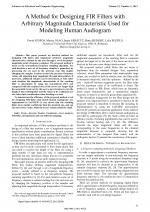| 2/2012 - 9 |
A Method for Designing FIR Filters with Arbitrary Magnitude Characteristic Used for Modeling Human AudiogramSZOPOS, E. |
| Extra paper information in |
| Click to see author's profile in |
| Download PDF |
Author keywords
discrete Fourier transforms, error analysis, FIR filter, interpolation and non-uniform sampling
References keywords
digital(7), filter(6), design(5), systems(4), circuits(4)
Blue keywords are present in both the references section and the paper title.
About this article
Date of Publication: 2012-05-30
Volume 12, Issue 2, Year 2012, On page(s): 51 - 56
ISSN: 1582-7445, e-ISSN: 1844-7600
Digital Object Identifier: 10.4316/AECE.2012.02009
Web of Science Accession Number: 000305608000009
SCOPUS ID: 84865294072
Abstract
This paper presents an iterative method for designing FIR filters that implement arbitrary magnitude characteristics, defined by the user through a set of frequency-magnitude points (frequency samples). The proposed method is based on the non-uniform frequency sampling algorithm. For each iteration a new set of frequency samples is generated, by processing the set used in the previous run; this implies changing the samples location around the previous frequency values and adjusting their magnitude through interpolation. If necessary, additional samples can be introduced, as well. After each iteration the magnitude characteristic of the resulting filter is determined by using the non-uniform DFT and compared with the required one; if the errors are larger than the acceptable levels (set by the user) a new iteration is run; the length of the resulting filter and the values of its coefficients are also taken into consideration when deciding a re-run. To demonstrate the efficiency of the proposed method a tool for designing FIR filters that match human audiograms was implemented in LabVIEW. It was shown that the resulting filters have smaller coefficients than the standard one, and can also have lower order, while the errors remain relatively small. |
| References | | | Cited By |
Web of Science® Times Cited: 2 [View]
View record in Web of Science® [View]
View Related Records® [View]
Updated today
SCOPUS® Times Cited: 3
View record in SCOPUS® [Free preview]
View citations in SCOPUS® [Free preview]
[1] Synthesis Tool Based on Genetic Algorithm for FIR Filters with User-Defined Magnitude Characteristics, Szopos, Ervin, Neag, Marius, Saracut, Ioana, Popescu, Victor, Topa, Marina, Circuits, Systems, and Signal Processing, ISSN 0278-081X, Issue 1, Volume 35, 2016.
Digital Object Identifier: 10.1007/s00034-015-0054-0 [CrossRef]
[2] Modelling Audiograms for People with Dementia Who Experience Hearing Loss Using Multiple Linear Regression Method, Elkhouly, Abeer, Rahim, Hasliza A, Abdulaziz, Nidhal, Abd Malek, Mohamed Fareq, 2020 International Conference on Communications, Computing, Cybersecurity, and Informatics (CCCI), ISBN 978-1-7281-7315-3, 2020.
Digital Object Identifier: 10.1109/CCCI49893.2020.9256679 [CrossRef]
[3] IIR filter synthesis based on Real-Coded Genetic Algorithm for human audiogram emulation, Szopos, Ervin, Saracut, Ioana, Farcas, Calin, Neag, Marius, Topa, Marina, 2015 International Symposium on Signals, Circuits and Systems (ISSCS), ISBN 978-1-4673-7488-0, 2015.
Digital Object Identifier: 10.1109/ISSCS.2015.7203955 [CrossRef]
Disclaimer: All information displayed above was retrieved by using remote connections to respective databases. For the best user experience, we update all data by using background processes, and use caches in order to reduce the load on the servers we retrieve the information from. As we have no control on the availability of the database servers and sometimes the Internet connectivity may be affected, we do not guarantee the information is correct or complete. For the most accurate data, please always consult the database sites directly. Some external links require authentication or an institutional subscription.
Web of Science® is a registered trademark of Clarivate Analytics, Scopus® is a registered trademark of Elsevier B.V., other product names, company names, brand names, trademarks and logos are the property of their respective owners.
Faculty of Electrical Engineering and Computer Science
Stefan cel Mare University of Suceava, Romania
All rights reserved: Advances in Electrical and Computer Engineering is a registered trademark of the Stefan cel Mare University of Suceava. No part of this publication may be reproduced, stored in a retrieval system, photocopied, recorded or archived, without the written permission from the Editor. When authors submit their papers for publication, they agree that the copyright for their article be transferred to the Faculty of Electrical Engineering and Computer Science, Stefan cel Mare University of Suceava, Romania, if and only if the articles are accepted for publication. The copyright covers the exclusive rights to reproduce and distribute the article, including reprints and translations.
Permission for other use: The copyright owner's consent does not extend to copying for general distribution, for promotion, for creating new works, or for resale. Specific written permission must be obtained from the Editor for such copying. Direct linking to files hosted on this website is strictly prohibited.
Disclaimer: Whilst every effort is made by the publishers and editorial board to see that no inaccurate or misleading data, opinions or statements appear in this journal, they wish to make it clear that all information and opinions formulated in the articles, as well as linguistic accuracy, are the sole responsibility of the author.



